Asset-based revitalization - Berlin to Close its Last Authentic Market Hall
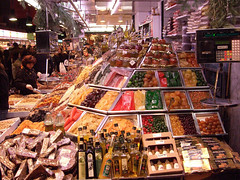 La Boqueria, Barcelona. Flickr photo by Federicochi.
La Boqueria, Barcelona. Flickr photo by Federicochi.When I write I rarely define the foundational principles of my perspective. Part of this is that to me, they seem so obvious that it isn't necessary. Of course, dealing with people in communities, on real issues, it becomes obvious that most people don't come to meetings armed with a set of foundational principles that undergird their reasoning on seemingly "urban" planning issues. When we attempt to discuss the issues, there is an incredible disconnect.
For example, this photo, cropped, from Karen Apricot', is now one of my all-time favorites, and illustrates the number one point that most urban residents, having originally hailed from the suburbs, don't understand. Developers too don't understand, given that for the last 50 years most retail development has been in the suburbs and is organized around automobility.
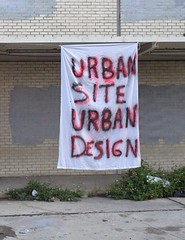
On a blog thread on Frozen Tropics, I listed the foundational principles of my approach to urban revitalization:
• asset-based revitalization;
• building a local economy;
• authenticity;
• community capacity building; and
• citizen engagement.
While the list starts with asset-based revitalization, each point is merely a different form of it. (And one of the better books on asset-based revitalization is Roberta Gratz's Cities: Back from the Edge.)
This comes up in response to an article that Mike Berman sent around by George Otto, about how "Berlin to Close its Last Authentic Market Hall" which will appear in the August issue of Urban Land. From the article:
The City of Berlin, Germany is planning to close the Marheineke Market Hall in the city’s Kreuzberg district. The famous food market is the last example in Berlin where each stand is independently owned. The city government is planning to renovate the historic building in order to provide the area with an underground parking facility and a new retail concept.
The market, which is owned and managed by the City of Berlin, is one hundred and fourteen years old. With over fifty independent food stands and more than one hundred and twenty workers the market is a citywide destination for many Berliners and tourists. “The Marheineke Market Hall is the center of our community and it provides real independence and pride to the stand owners, many of whom have worked here for more than forty years,” said Christoph Schulz, a community activist in Kreuzberg. ...
Although the Marheineke Market Hall is profitable and very much alive the city has asked the stand owners to prepare to close their businesses with a “no promises option” to return to the new concept retail center after one to two years.
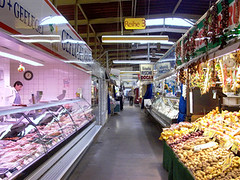 Marheineke Market, Berlin, photo by Edith Siepmann.
Marheineke Market, Berlin, photo by Edith Siepmann.Given how we think about how Germans act, it makes sense, doesn't it, that a public market in Germany is less rambunctious--read messy and gritty--compared to La Boqueria in Barcelona. Check out Flickr for some incredible photos of La Boqueria.
Here's what I wrote in response to Michael's email:
I don't find this kind of thinking surprising at all. It's tragic, but expected.
The same thing is happening in DC with the Florida Market area, and it wasn't that long ago when people wanted to change DC's Eastern Market into a food court.
Even in the City of Washington, which is more "European" in the core city compared to most other cities in the U.S., there are but a handful of us who are consistent and uncompromising advocates for quality, beauty, and livability in terms of the development of new public and private places and spaces and the revitalization of older places.
But we do this in the face of the dominance of the scene by developers, elected officials who have, for the most part, a suburban mentality about place and development, and as far as suburban as opposed to urban placemaking principles go, they have the courage of their convictions, and residents who:
(1) have been imprinted with a car-centric single-use suburban development and planning paradigm--most city residents grew up in suburbs;
(2) don't know much about architecture and placemaking; and
(3) not only don't advocate for quality, but work actively to rollover, give in, and work to denigrate the activities of those of us who strive for better.
More and more and more and more and more I look at this through the lens "exchange value" vs. "use value" of place as described by Harvey Molotch in the article "City as a Growth Machine."
Developers call the shots in most cities, especially in weak real estate markets like Baltimore... or Berlin. Few developers are advocates of placemaking beyond its quantifiable economic returns ("exchange value") within the context of a specific development.
Plus in a place like Berlin that is "desperate" to become a successful part of the European economy (the area formerly known as East Germany lags significantly economically compared to the western part of the country--in fact the government sponsors a research project on Shrinking Cities), I am sure that city "fathers" and the developers are eager to do the kind of development that they think is advanced or modern, but is merely a warmed over version of "festival marketplace" or mall-like developments that cities seized upon in the 1970s and 1980s.
______
Plus, both the Urban Land Institute and the International Council of Shopping Centers aasociations are active in Euripe, and members are likely to be promoting development types and models that were honed in North America. Relatedly, U.S. style shopping malls are being developed all across India.
______
This reminds me of an article from 1962 titled the "Economic Advantages of Backwardness" by Alexander Gershenkron. He makes the point that redeveloping economies can adopt the newest technologies, because they don't have to worry about stranded costs embodied in massive investments in now older technologies.
Unfortunately, many cities concerned with revitalization--or at the least many developers and elected officials in such cities--believe that their biggest asset--their authentic, usually historic assets--is their reason for failure. Yet in the U.S. at least, historic preservation and/or people-based revitalization strategies are the only successful and sustainable strategies that work long term.
Most areas that have experienced urban renewal in the U.S. are now in the process of being redeveloped, because the first generation attempt didn't work. Meanwhile, places that focus on asset-based revitalization continue to chug along and go through various stages of rebirth.
Mati Senerchia pointed out that Europe offers another example of a similar redevelopment, one that failed miserably, Les Halles in Paris, where a market district was removed to the suburbs and replaced with an antiseptic and mostly underground shopping mall. Like most urban renewal projects in the United States, 30 years later they have to "redevelop" the site because it has failed.
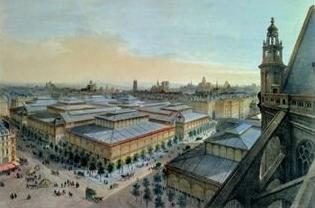 View of Les Halles in Paris, from Saint Eustache Upper Gallery, circa 1870-80. By Felix Benoist.
View of Les Halles in Paris, from Saint Eustache Upper Gallery, circa 1870-80. By Felix Benoist.I wish that the lessons of the failures of urban renewal would take better in the United States, instead of getting transmogrified and warmed over into the seemingly new, but really more of the same. Such as the ideas of the president of the Anacostia Waterfront Corporation to create a placeless shopping "mecca" on the SW waterfront of Washington DC, or Councilmember Orange's ideas to demolish the Florida Market and build new but retain current businesses--while increasing their rents 4-5 times!
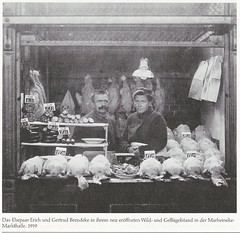 Marheineke Market, Berlin, historical photo.
Marheineke Market, Berlin, historical photo.History (assets and authenticity) is so easy to dispose of and yet impossible to replace.
Index Keywords: asset-based-revitalization; urban-revitalization; food-agriculture-markets



0 Comments:
Post a Comment
<< Home